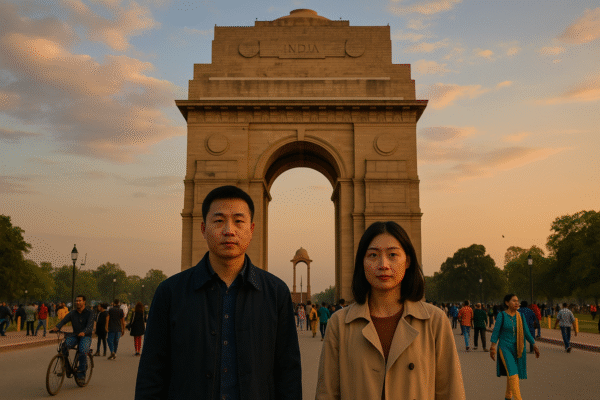India Resumes Tourist Visas for Chinese Nationals After Five-Year Hiatus, Signaling Diplomatic Thaw
In a significant move toward restoring bilateral ties, the Indian government has resumed issuing tourist visas to Chinese nationals after a five-year suspension. This major policy shift, announced by the Indian Embassy in Beijing on the Chinese social platform Weibo, went into effect Thursday, July 25, 2025. The development marks a potential turning point in India-China relations, which had severely deteriorated following a deadly military clash on their disputed Himalayan border in June 2020.
The reinstatement of tourist visa services is part of India’s broader effort to reduce tensions with its northern neighbor. It comes on the heels of several high-level diplomatic engagements and reflects growing momentum toward normalization, especially in the areas of tourism, economic cooperation, and people-to-people exchange.
A Shift in India-China Relations
India had suspended tourist visas for Chinese nationals in response to the Galwan Valley clash, where 20 Indian soldiers and an undisclosed number of Chinese troops were killed. The incident, which took place along the Line of Actual Control (LAC) in eastern Ladakh, ignited a series of retaliatory measures, including bans on Chinese investments and popular mobile apps such as TikTok, WeChat, and Shein.
In recent months, however, both sides have signaled a willingness to de-escalate tensions. The resumption of visa services follows the October 2024 meeting between Indian Prime Minister Narendra Modi and Chinese President Xi Jinping on the sidelines of the 16th BRICS Summit in Kazan, Russia. That dialogue reportedly laid the groundwork for improved communication and trust-building efforts.
Chinese Government Welcomes India’s Decision
China’s Ministry of Foreign Affairs applauded India’s move as a “positive signal” toward mending fractured relations. “Easing cross-border travel between China and India is widely beneficial and promotes mutual understanding,” said spokesperson Guo Jiakun. “We will maintain active communication with India to further facilitate bilateral exchanges.”
Prior to the visa freeze, China was among India’s top 20 inbound tourism markets. According to India’s Ministry of Tourism, over 280,000 Chinese tourists visited India in 2019 alone, contributing significantly to the Indian economy through business, heritage, wellness, and spiritual travel.
The resumption of travel not only revives a once-thriving tourism link but also holds promise for rejuvenating cultural and educational exchanges between Asia’s two largest countries.
Economic and Cultural Benefits
Industry experts suggest that this move could help India rebound further in its post-COVID tourism recovery, especially as international visitor numbers steadily increase. “This decision signals India’s readiness to re-engage not just diplomatically, but economically,” said Dr. Arvind Raghavan, a New Delhi-based geopolitical analyst. “Tourism is a soft power tool, and India is wisely using it to extend an olive branch.”
The Confederation of Indian Industry (CII) also welcomed the development, highlighting the importance of Chinese tourist spending across sectors including aviation, hospitality, and retail. Direct flights between Indian cities such as Delhi and Mumbai and Chinese metropolises like Beijing, Shanghai, and Guangzhou are expected to gradually resume to accommodate rising demand.
Border Disputes Still Unresolved
Despite the renewed focus on travel and diplomacy, the LAC issue remains unresolved. According to India’s Ministry of External Affairs, both sides continue to engage in military and diplomatic talks to reduce friction along the disputed border. A new round of talks is scheduled to take place later this year in New Delhi, with working groups focusing on demarcation and mutual disengagement.
India has clarified that the resumption of visa services does not imply resolution of core strategic issues. “Border security and national sovereignty remain non-negotiable,” said a senior MEA official. “But engagement on other fronts, like tourism, can continue in parallel.”
A Broader Shift in Foreign Policy
India’s decision to allow Chinese tourists back also reflects a more balanced foreign policy strategy. As the world’s most populous nations and regional economic powerhouses, both India and China have much to gain from stabilized relations. With global economic uncertainty, climate challenges, and regional security concerns, cooperative diplomacy between the two nations is essential.
According to government data from the India Tourism Statistics 2024 report, inbound tourism from neighboring Asian countries is projected to grow by 15% in 2025, boosted by relaxed visa policies and greater airline connectivity. China’s reintegration into that forecast could amplify those numbers.
Conclusion: Rebuilding Trust Through Tourism
India’s reopening of tourist visas to Chinese citizens is more than a bureaucratic shift—it’s a signal that diplomacy is alive, even after years of distrust. While the Himalayan border dispute remains a thorny issue, the ability for citizens to cross borders for leisure and cultural exchange could plant the seeds for deeper cooperation.
As both countries navigate a complex geopolitical landscape, this gesture from New Delhi opens a new chapter—one that prioritizes engagement over exclusion, and dialogue over division.
For Chinese travelers eager to explore India’s diverse landscapes, spiritual heritage, and vibrant markets, the doors are now open once more. And for India, the return of Chinese tourists could mean not just economic revival, but a step closer to regional stability.
For more travel news like this, keep reading Global Travel Wire



















